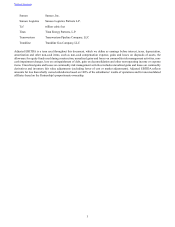Energy Transfer 2012 Annual Report Download - page 21
Download and view the complete annual report
Please find page 21 of the 2012 Energy Transfer annual report below. You can navigate through the pages in the report by either clicking on the pages listed below, or by using the keyword search tool below to find specific information within the annual report.
13
system and to pipeline interconnects at the California border. The Transwestern pipeline has access to three significant gas basins:
the Permian Basin in West Texas and eastern New Mexico; the San Juan Basin in northwestern New Mexico and southern Colorado;
and the Anadarko Basin in the Texas and Oklahoma panhandle. Natural gas sources from the San Juan Basin and surrounding
producing areas can be delivered eastward to Texas intrastate and mid-continent connecting pipelines and natural gas market hubs
as well as westward to markets in Arizona, Nevada and California. Transwestern’s Phoenix lateral pipeline, with a throughput
capacity of 500 MMcf/d, connects the Phoenix area to the Transwestern mainline.
Transwestern’s customers include local distribution companies, producers, marketers, electric power generators and industrial
end-users. Transwestern transports natural gas in interstate commerce.
Panhandle Eastern Pipeline
• Capacity of 2.8 Bcf/d
• Approximately 6,000 miles of interstate natural gas pipeline
The Panhandle Eastern pipeline’s transmission system consists of four large diameter pipelines extending approximately 1,300
miles from producing areas in the Anadarko Basin of Texas, Oklahoma and Kansas through Missouri, Illinois, Indiana, Ohio and
into Michigan. Panhandle Eastern pipeline is owned by a subsidiary of Holdco.
Trunkline Gas Pipeline
• Capacity of 1.7 Bcf/d
• Approximately 3,000 miles of interstate natural gas pipeline
The Trunkline Gas pipeline’s transmission system consists of two large diameter pipelines extending approximately 1,400 miles
from the Gulf Coast areas of Texas and Louisiana through Arkansas, Mississippi, Tennessee, Kentucky, Illinois, Indiana and to
Michigan. Trunkline Gas pipeline is owned by a subsidiary of Holdco.
Tiger Pipeline
• Capacity of 2.4 Bcf/d
• Approximately 195 miles of interstate natural gas pipeline
• Bi-directional capabilities
The Tiger pipeline is an approximately 195-mile interstate natural gas pipeline that connects to our dual 42-inch pipeline system
near Carthage, Texas, extends through the heart of the Haynesville Shale and ends near Delhi, Louisiana, with interconnects to at
least seven interstate pipelines at various points in Louisiana. The pipeline has a capacity of 2.4 Bcf/d, all of which is sold under
long-term contracts ranging from 10 to 15 years.
Fayetteville Express Pipeline
• Capacity of 2.0 Bcf/d
• Approximately 185 miles of interstate natural gas pipeline
• 50/50 joint venture through ETC FEP with Kinder Morgan Energy Partners, L.P. (“KMP”)
The Fayetteville Express pipeline is an approximately 185-mile interstate natural gas pipeline that originates near Conway County,
Arkansas, continues eastward through White County, Arkansas and terminates at an interconnect with Trunkline Gas Company
in Panola County, Mississippi. The pipeline has long-term contracts for 1.85 Bcf/d ranging from 10 to 12 years.
Sea Robin Pipeline
• Capacity of 1.9 Bcf/d
• Approximately 1,000 miles of interstate natural gas pipeline
The Sea Robin pipeline’s transmission system consists of two offshore Louisiana natural gas supply systems extending
approximately 81 miles into the Gulf of Mexico. Sea Robin pipeline is owned by a subsidiary of Holdco.
Table of Contents
























